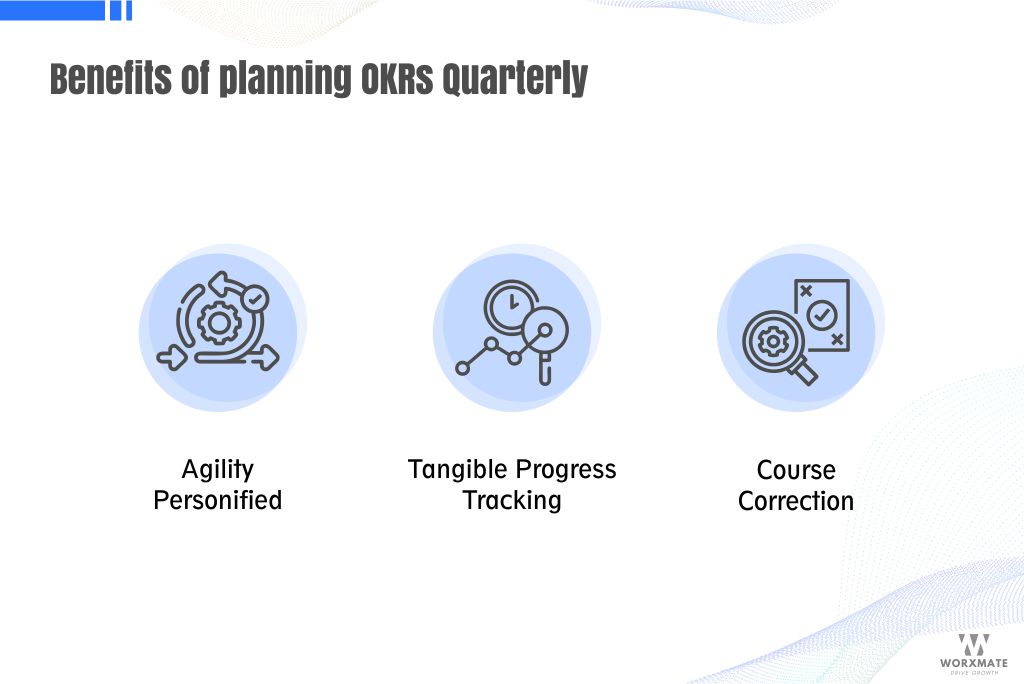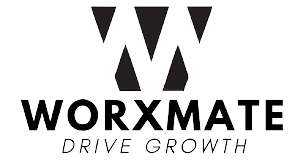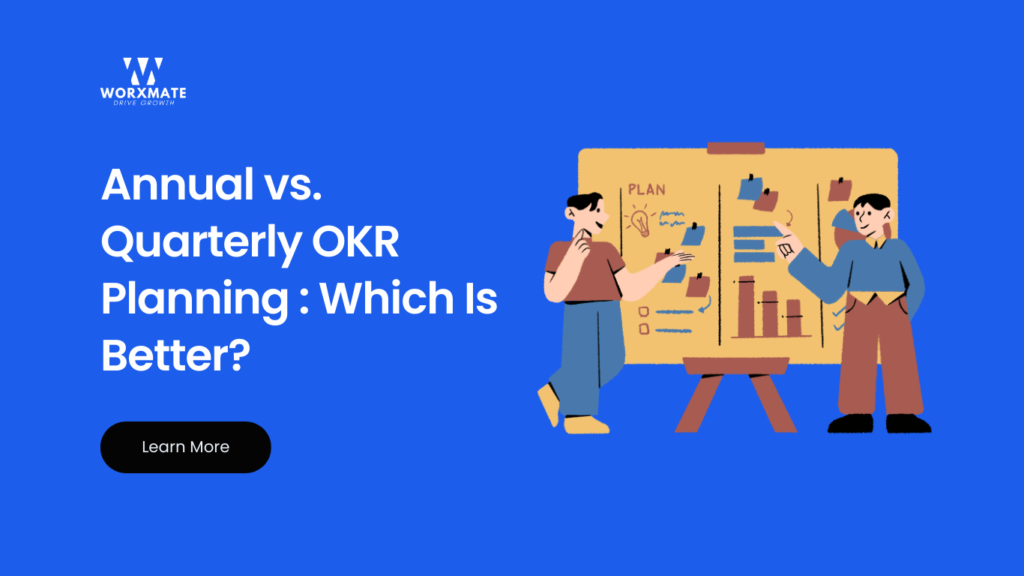Maintaining a competitive advantage today requires more than just a blueprint; it also requires an ongoing commitment to agility, adaptation, and strategic foresight. OKRs have emerged as critical tools for organizations looking to not just set but exceed lofty targets.
OKRs have emerged as indispensable instruments for organizations seeking to not just set but surpass ambitious goals. Yet, the critical question remains: Which planning cadence—quarterly agility or annual breadth—best serves the needs of your organization?
Delving into the intricacies of each approach reveals a myriad of benefits and considerations. Quarterly planning, characterized by its rapid pace and iterative nature, excels in environments where swift responses to market shifts and continuous improvement are paramount.
On the other hand, annual planning provides a comprehensive framework for long-term strategic alignment and resource allocation, fostering a cohesive organizational vision.
As we navigate this decision, it becomes evident that the optimal approach lies in finding the delicate balance between adaptability and foresight, tailored to the specific goals and circumstances of each unique organization.
Quarterly OKR Planning: The Sprint to Success
Imagine your business as a sprinter on the track, aiming for short bursts of acceleration towards the finish line. Quarterly OKR planning embodies this analogy, focusing on rapid iterations and immediate feedback loops.
Here’s why it’s compelling:
Agility Personified:
Quarterly OKR planning allows organizations to swiftly pivot in response to market dynamics, emerging trends, or internal shifts. It’s akin to adjusting the sails of a ship to navigate changing winds, ensuring your organization remains on course despite external turbulence.
Tangible Progress Tracking:
With shorter timeframes, progress towards objectives becomes more tangible and measurable. This transparency fosters accountability and motivation among teams as they witness the direct impact of their efforts within a relatively brief period.
Course Correction:
Quarterly cycles offer ample opportunities for course correction. If an objective isn’t yielding the expected results or market conditions evolve unexpectedly, teams can recalibrate their strategies without waiting for an entire year to pass.

Annual OKR Planning: The Marathon of Strategy
Now, picture your business as a marathon runner, pacing themselves for the long haul. Annual OKR planning embodies this endurance, focusing on broader strategic horizons and deeper organizational alignment. Here’s why it’s indispensable:
Holistic Vision:
Annual OKR planning encourages organizations to adopt a panoramic view of their goals, encompassing long-term aspirations and overarching strategies. It’s about laying the foundation for sustained growth and resilience rather than chasing immediate wins.
Resource Allocation:
Longer planning cycles enable better resource allocation, allowing organizations to align budgets, talent, and infrastructure with their strategic objectives. This foresight minimizes inefficiencies and maximizes the impact of investments.
Cultural Cohesion:
Annual OKR planning fosters a sense of cultural cohesion and organizational identity. Rallying teams around a shared vision for the entire year cultivates a deeper sense of belonging and commitment, essential for weathering challenges and seizing opportunities together.
Annual vs Quarterly OKRs: Determining the Superior Approach
Establishing annual goals is undoubtedly essential, yet complementing them with quarterly OKRs is equally imperative. Why, you may ask? The rationale is multifaceted: integrating quarterly OKRs ensures sustained focus, enhances employee engagement, and catalyzes incremental improvements on a quarterly, monthly, and even weekly basis.
Numerous studies have underscored a robust correlation between employee engagement levels and key performance outcomes, including but not limited to profitability, productivity, and retention rates. For instance, according to a Gallup report, a lack of engagement costs the global economy $7.8 trillion, which accounts for up to 11% of GDP worldwide.
So, in the perpetual quest for organizational excellence, the debate between annual and quarterly OKRs simmers with significance. While annual OKRs offer a panoramic view of objectives, fostering long-term strategic alignment and resource allocation, quarterly OKRs embody agility, facilitating rapid adaptation to dynamic market landscapes and fostering a culture of continuous improvement.
The choice between the two hinges on factors such as organizational culture, industry dynamics, and the nature of the objectives pursued.
Annual OKRs provide a cohesive framework for long-term planning and investment, fostering a sense of unity and purpose among teams. Conversely, quarterly OKRs thrive in environments where responsiveness and agility are paramount, enabling swift course corrections and maximizing adaptability.
Ultimately, the decision lies in striking a balance between strategic foresight and operational agility, tailoring the approach to suit the unique needs and objectives of the organization.
Choosing Your Rhythm: A Call to Action
As you navigate the terrain of OKR planning, remember that there’s no one-size-fits-all approach. The decision between quarterly and annual cycles hinges on factors such as organizational culture, industry dynamics, and the nature of your objectives. However, regardless of your chosen rhythm, the essence of OKR planning lies in its adaptability and alignment.
So, here’s your call to action:
Evaluate Your Context:
Reflect on your organization’s culture, market environment, and strategic priorities to determine the most suitable planning cycle.
Experiment and iterate:
Don’t hesitate to experiment with different cadences or hybrid approaches. Embrace a culture of continuous improvement, where feedback fuels evolution.
Stay Focused, Stay Agile:
Whether you opt for the sprint or the marathon, remember that the essence of OKR planning lies in its ability to keep your organization focused, agile, and relentlessly aligned towards its North Star.
In the fast-evolving realm of business, achieving success hinges on the artful fusion of strategic foresight with the agility to pivot and the courage to dream big while remaining adaptable. Therefore, it’s time to prepare for action: tighten the laces of your shoes, find your cadence, and dive headfirst into the thrilling expedition of OKR planning.
Recognize that with every forward motion, you’re not just progressing, but unraveling the myriad possibilities that lie within your organization, propelling it toward the zenith of its capabilities. Embrace the journey with zeal, for it is through this journey that you’ll unearth the true essence of your organization’s potential and chart a course toward unparalleled achievements.
Now, it’s time to take the next step!
Explore the Best OKR Software to empower your team with the tools needed for seamless planning and execution. With the right OKR software, you can easily track progress, adapt in real-time, and drive alignment at every stage of your journey. Start exploring today and unlock your organization’s full potential!




